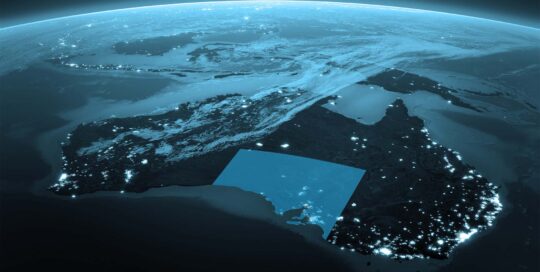The development of South Australia’s first state satellite has taken a giant leap toward delivering tangible data solutions, following the successful completion of the Critical Design Review (CDR).
This step marks a major milestone for the South Australian Space Services Mission satellite, Kanyini, with the project team finalising the design of the 6U spacecraft with integrated payloads and initiating the start of its manufacture and test phase.
Founder and CEO of Inovor Technologies, the company responsible for Kanyini’s design and build, Dr Matthew Tetlow said the success of the CDR gave the green light for the project’s next phase.
“The successful CDR – this confidence in the design of the spacecraft – provides a boost as we head towards the next big milestone which is to test and integrate the payloads into the satellite which will provide services to the South Australian government,” Dr Tetlow said.
“The process of building a spacecraft with our project partners is dynamic – the mission has a very complex payload suite which has given our team the chance to be innovative and creative in developing solutions to meet the mission requirements.
“We’ve all risen to the challenge – kudos to everyone involved.”
One research project conducted through the SmartSat CRC has already demonstrated reliable, cost-effective monitoring of the Department of Environment’s extensive network of groundwater bores through Internet of Things (IoT) and nano-satellite telecommunications will be utilising the technology onboard Kanyini.
The research project, conducted by FrontierSI, Myriota, UniSA, NGIS Australia and Department for Environment and Water, has resulted in the development of an end-to-end solution for transmitting and aggregating automatically collected information from bores across rural and regional South Australia, with a focus on environmental water monitoring.
FrontierSI Deputy CEO, Phillip Delaney, reinforced the project’s success and praised the collaboration the South Australian Government and SmartSat CRC.
“We have been working closely with Myriota, UniSA, NGIS Australia, and the Department for Environment and Water over the past two years to demonstrate the transformative use of Internet-of-Things and nanosatellite communications to improve groundwater bore monitoring and management in the harsh environment of remote Australia,” he said.
“This project has created a wealth of information on groundwater, transforming once per year updates on groundwater into data points multiple times per day. This will be critical to underpinning decision making, reactive to events, and understanding the impacts of developments on the whole groundwater network.”
“Importantly, as many of these sites are in hard, remote environments, there are substantial safely benefits gained by reducing the number of times these sites need to be visited.”
“All of these benefits would not be possible without this transformation space enabled communications technology. Congratulations to the South Australian Government, the SIGWater project team, and SmartSat CRC for their collaboration and belief in this innovative body of work.”
With much of Australia’s groundwater being a main source of drinking water for many regional townships and heavily utilised by agriculture, mining and the energy sectors, this project has the potential to significantly optimise groundwater optimisation, reduce staff field time and increase the availability of groundwater information.
SmartSat CRC Chief Executive Officer Andy Koronios said state’s investment in Kanyini is providing researchers with a vehicle to develop real-world technology based on their research to the benefit of a range of stakeholder.
“We are dedicated to developing satellite IoT connectivity technologies that help solve some of the biggest challenges facing Australian industries, and that includes water security for our environment, community and the economy” Prof Koronios said.
“With over a third of the world’s biggest groundwater systems already in distress, this project will put Australia in pole position to be a global leader in groundwater management and apply the solution locally and abroad. It is fantastic to know that we can deliver this technology to space aboard a sovereign satellite such as Kanyini.”
“The data captured by this satellite will help progress valuable research into satellite technology. We are continuing to look at new projects that will provide services for the South Australian Government.”
As IoT lead for the mission, Myriota co-founder and Chief Technology Officer, Dr David Haley added that the data collected would have enormous benefits for users here on Earth.
“The success of the Kanyini Critical Design Review marks the beginning of a new phase of the program where the Myriota and Inovor teams will proceed with assembly, integration and testing of the spacecraft and its two payloads,” Dr Haley said.
“The Internet of Things payload will add to the Myriota Network, collecting data from devices and sensors on the Earth’s surface, working together with hyperspectral imaging collected from the earth observation payload to support a wide array of applications including aiding farmers in monitoring water levels so they can more accurately predict future crop yields and supporting emergency services personnel to monitor, manage and mitigate emergencies like bushfires.”
The launch of Kanyini – the SASAT1 Space Services Mission – will be a game changer for the South Australian space sector, delivering space-derived services for applications across government and commercial use. It also places South Australia firmly at the centre of Australia’s endeavours to build space heritage, provide secure access to data from space and expand our satellite design and manufacturing capability.
In collaboration with the South Australian Government, the SmartSat Cooperative Research Centre (CRC) is leading the mission and application prototyping, with Adelaide-based commercial satellite manufacturer Inovor Technologies responsible for Kanyini’s design and build, and Adelaide-based global space company Myriota contracted for Internet of Things (IoT) space services.
Follow Kanyini’s journey at saspacemission.com.au





